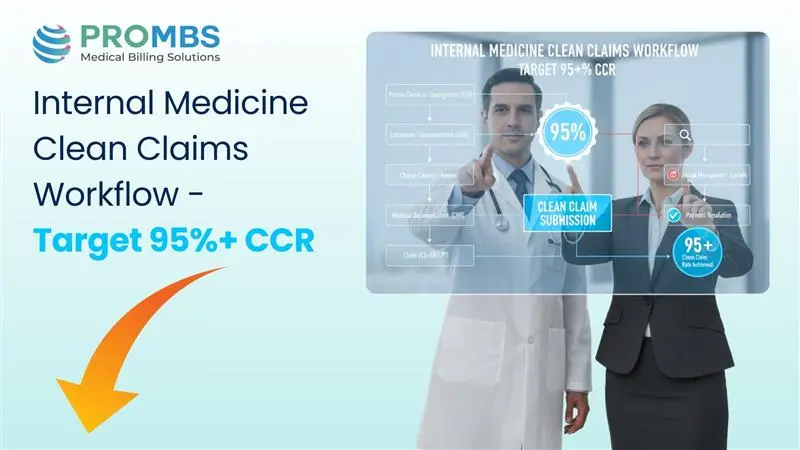Gold is a hard currency. Paper claims? That's fiction. The Internal Medicine Clean Claims Workflow starts now. Every claim filed is a wager. The Clean Claims Rate (CCR) tells you if you're a gambler or a fool. Ninety-five percent.
That's the house edge we aim for. If you miss that mark, you aren't running a clinic. You're running a charity. Every denial isn't a mistake; it's a hole in your roof. It's time wasted chasing pennies that should have been gold coins on day one. To secure that revenue from the outset, mastering the Internal Medicine Clean Claims Workflow is non-negotiable.
Why Is Internal Medicine So Vulnerable to Claims Denials?
Why does the system hate us? Because we deal with reality. We don't solve problems with one quick stroke. We manage chronic ailments - the slow rot. Payers prefer simple tales. Internal Medicine is complex truth. We struggle with Evaluation and Management (E/M) codes. Fail to document the why of the patient visit, and the payer's axe falls. The sheer volume and subjective nature of these codes make them a primary target for audits, a difficulty well-documented in regulatory guidance, according to the Office of Inspector General (OIG, 2023).
They want proof of Medical Decision Making (MDM). If your scribbles are weak, your coffer remains empty. The complexity of chronic care - managing hypertension, diabetes, and heart failure in a single thirty-minute visit - is the true monster. Yet, the payer only sees a single time unit. This constant mismatch between the clinical intensity and the documentation requirements, as per the detailed guidelines provided in the AMA CPT Manual (AMA, 2024), often results in down-coding, a persistent burden.
| Denial Category | Common Internal Medicine Cause | CCR Impact |
|---|---|---|
| Eligibility/Demographics | Outdated insurance information or incorrect subscriber ID. | Leads to outright rejection (hard denial). |
| Coding/Documentation | E/M documentation fails to support the billed complexity (MDM). | Triggers down-coding or appeal requirement. |
| Prior Authorization (PA) | PA not obtained for necessary diagnostic tests or specialty drugs. | Claim denied as "non-covered service." |
The fault is in the asymmetry of information. The payer demands quantifiable proof that the level of service billed (the E/M code) corresponds precisely to the risk and complexity managed (the MDM components). Failure to align this technical documentation is not seen as an oversight, but as an unjustified claim for higher reimbursement. This table maps the three primary breaches in the workflow where the coin is most frequently lost.
How Can Front-End Workflow Stop Eligibility Errors at the Gate?
The fight begins at the door. Not in the back office. What's the easiest way to lose? Bad intel. Always verify eligibility 48–72 hours pre-visit. Don't wait for the patient to shrug and hand over a crumbled card. Trust the system, not the man. This proactive step identifies deductible status, copay amounts, and potential coverage gaps before the service is rendered. This is a foundational step for any successful Internal Medicine Clean Claims Workflow.
The cost of a few minutes of staff time is nothing compared to the 90 days you spend trying to collect from a patient who claims ignorance. Establish a simple Patient Demographics Checklist. This is your first guard duty. Fail here, and the claim is a corpse.
Does Your Documentation Support Complex E/M Codes (CDI)?
The note is the weapon. Keep it sharp. Is your documentation a convincing lie? It must justify a 99214 or 99215. The AMA dictates that MDM is the key. Is your documentation of data review exhaustive?
Did you clearly state the complexity of the problems addressed? The CMS watches. The problem isn't the healing you performed; it's the poor story you told about it. Provider education focused on the MDM elements is the only salvation for maintaining the integrity of the Internal Medicine Clean Claims Workflow.
- Complexity of Problems: Did you list the number of problems? Was one a high-risk, acute illness? Was another a stable chronic condition? The documentation must reflect the highest level of complexity managed.
- Data Review: Did you explicitly note that you reviewed old records from a specialist? Did you independently interpret a complex diagnostic test (like an EKG)? Simply stating "Labs reviewed" is not enough to support a high-level E/M.
- Risk: What did you prescribe? Was it a high-risk medication? Was the management plan based on a major decision, such as hospital admission or a complex procedure referral?
The provider must understand that the payment is tied not to the time spent, but to the cognitive effort documented. Without this specificity, any audit will result in a down-coding. The payer won't debate your clinical skill. They only read the paper.
Are You Mastering Modifiers to Avoid Coding Conflicts?
Modifiers are the small print. Ignore them at your peril. The common, crippling curse? Modifier -25. When do you cast this spell? When the E/M service (managing the patient’s diabetes) is significant and separately identifiable from the minor procedure (a simple skin biopsy) done on the same day.
This is a recurring denial trap. Your documentation must support both services being medically necessary. Failure to append the -25 modifier means the payer will bundle the E/M service into the payment for the procedure, essentially stealing the payment for the complex cognitive work.
Another trap? Using Modifier -33 (Preventive service). When billing screening procedures, ensure this modifier is used correctly to signal that the service should be covered without patient cost-sharing, avoiding unexpected patient balances that lead to bad debt.
| Modifier | Purpose | Typical IM Use Case |
|---|---|---|
| -25 | Separate E/M on day of procedure. | Billing 99214 and 90471 (vaccine admin) together. |
| -59 | Distinct procedural service. | Billing two non-bundled, separate procedures on the same day. |
| -33 | Preventive service. | Used with screening codes to indicate the service was preventive and should be covered without cost-sharing. |
Modifiers are the critical flags of the claims process - small codes with massive power, much like the esoteric symbols of old magic. Use them correctly, and your claim survives the bureaucratic encounter; falter, and the payer's axe falls, bundling your hard-won coin away. The wise practitioner knows the difference between a simple service and a complex, separately identifiable encounter.
Why is Claims Scrubbing Essential for a Clean Claims Workflow?
Don't trust luck. Trust code. Claims scrubbing is the final filter. It reviews your submission against a million payer rules. It catches mistakes your billers miss. This technology is vital for identifying incompatible code pairs and ensuring compliance with CCI Edits published by CMS.
The scrubber acts as an automated auditor, verifying that the diagnostic codes match the procedure codes and checking for correct bundling. This proactive measure is central to a strong Internal Medicine Clean Claims Workflow. What is the value of finding the flaw before the payer does? It means you get paid. First time. Every time.
How Can You Tame the Prior Authorization (PA) Bottleneck?
Prior Authorization (PA) is bureaucratic quicksand. How do we escape it? Proactivity. Designate a team to secure the authorization before the service is scheduled. If the PA is required for specialty drugs or diagnostics, move fast.
This team must track the payer-specific PA requirements, which can change monthly. A denied PA is a hole in your purse you can't stitch closed. It’s revenue you will never recover. Integrate this administrative process tightly into your Internal Medicine Clean Claims Workflow.
What is the Root Cause Analysis Approach to Denial Management?
Don't just fix the denial. Fix the reason. What's the truest measure of a good operation? The First-Pass Resolution Rate (FPR). Track it. Then, perform a Root Cause Analysis (RCA) on your top five denial codes. Which team failed? The front desk? The clinician? The coder? The answer points to the weak link that must be forged stronger to perfect your Internal Medicine Clean Claims Workflow.
This RCA process requires discipline:
- Categorize: Group denials by type (e.g., Eligibility, Lack of PA, Documentation).
- Identify Top Payers: Which insurer causes the most pain? Often, denial patterns are payer-specific.
- Address Systemically: If a denial is due to a missing modifier, update the EHR template or the scrubbing rules. Don't just re-file the single claim. Fix the process.
This shift from reactive filing to proactive system repair is the difference between a struggling practice and a solvent one.It is the moment the healer stops chasing fires and starts sealing the cracks where the smoke is born. It is the slow, steady tightening of loose threads in a system that has frayed for far too long.
A change that doesn’t shout, but settles - quiet, deliberate - into every workflow, every claim, every line of the record. And as the repairs take root, the panic fades. The ledger steadies. Days stop feeling like battles and start feeling like work done with purpose. In that calm, a practice remembers what strength feels like: not louder effort, but cleaner ground beneath its feet.
What KPIs Prove the Success of Your New Workflow?
| KPI | Target | Description |
|---|---|---|
| Clean Claims Rate (CCR) | ≥ 95% | Claims paid correctly upon first submission. |
| First-Pass Resolution Rate (FPR) | ≥ 90% | Claims that require absolutely no re-work or appeal. |
| Denial Rate (Overall) | ≤ 5% | Percentage of claims rejected by payers. |
| Days in A/R | ≤ 45 days | Average time from service to payment. |
These are the numbers that matter. Ignore them, and you might as well leave your clinic door unlocked for the tax collector. The CCR and FPR are the shields you carry into battle; the Denial Rate is the wound count; and Days in A/R is the swiftness of your victory. The wise healer knows that coin in hand today is worth two promises tomorrow.
Partner with Pro-MBS for Your Internal Medicine Clean Claims Workflow
You heal. We secure the coin. You have fought well, striving for that $95\%+$ CCR, but the administrative chaos - the denied claims, the endless appeals, the slow, agonizing leak of revenue - is a monster best left to the specialists. It is the complexity of the Internal Medicine billing landscape itself that binds your hands and keeps your practice from true solvency. a burden frequently highlighted by industry reports detailing high administrative costs, according to the Healthcare Financial Management Association.
To break that curse, you partner with Pro-MBS. We provide the expert coding - specialized in Internal Medicine E/M documentation - which ensures every complex cognitive visit is properly valued. Our advanced analytics run the deep Root Cause Analysis (RCA) you require, identifying the precise weak points in your workflow.
We are the dedicated account management maintaining the workflow standard, forging an unyielding Internal Medicine Clean Claims Workflow so you can focus on the blood and bone, certain that your earned coin is secure.
Frequently Asked Questions
How do I reach a 95%+ Clean Claims Rate in Internal Medicine?
You reach it by hunting errors before they breathe. Eligibility checks, sharp documentation, precise E/M Coding, and strong Claims Scrubbing form the path. A 95%+ CCR is not luck. It is discipline carved into the workflow. The Internal Medicine Clean Claims Workflow demands this level of order. For a system that protects every claim, let Pro-MBS secure your revenue.
Why do Internal Medicine claims get denied so often?
Internal Medicine carries complexity that payers dislike. Chronic conditions, layered histories, and unforgiving MDM create room for doubt. One weak line in the note can break the claim. The Internal Medicine Clean Claims Workflow shields your work from that blow. For fewer denials and stronger coding, trust Pro-MBS.
How does better documentation improve my CCR and FPR?
Documentation is the foundation of every claim. Clear MDM, detailed problem lists, and strong decision-making create claims that stand firm. When the story is solid, CCR rises and FPR stays steady. The Internal Medicine Clean Claims Workflow depends on clarity, not guesswork. For documentation that holds under pressure, work with Pro-MBS.
Why is E/M Coding important for Internal Medicine?
E/M Coding captures the true weight of your cognitive work. It transforms complexity and risk into a score that payers recognize. If the coding does not match the story, they cut the payment without hesitation. The Internal Medicine Clean Claims Workflow treats E/M as a core pillar. For coding accuracy that protects your revenue, partner with Pro-MBS.
How do Modifiers 25, 59, and 33 prevent billing conflicts?
Modifiers act as signals that defend the claim. Modifier 25 protects your E/M. Modifier 59 separates distinct procedures. Modifier 33 marks preventive services. If they are used carelessly, revenue slips away. The Internal Medicine Clean Claims Workflow requires precision in every modifier. For correct usage every time, rely on Pro-MBS.
Why is Claims Scrubbing essential in Internal Medicine?
Because you cannot trust chance. Claims Scrubbing finds incompatible codes, missing modifiers, and hidden logic errors before the payer sees them. It strengthens CCR and cuts denials at the root. In the Internal Medicine Clean Claims Workflow, the scrubber is the final guard. For advanced scrubbing that never fails, choose Pro-MBS.
How do Prior Authorization delays reduce revenue?
Prior Authorization is the trap that catches clinics off guard. One missed detail and the payer blocks payment before the visit begins. Each denied PA drains revenue. The Internal Medicine Clean Claims Workflow treats PA as a priority, not an afterthought. For a team that handles PA with urgency, turn to Pro-MBS.
How does Root Cause Analysis reduce denials long-term?
Root Cause Analysis reveals where the workflow breaks. It uncovers front desk errors, weak notes, missing modifiers, and eligibility failures. Fixing these flaws lifts FPR and lowers denials. The Internal Medicine Clean Claims Workflow depends on this discipline. For deep RCA and long-term stability, trust Pro-MBS.
Which KPIs matter most for Internal Medicine billing?
Four metrics rule the system: CCR, FPR, Denial Rate, and Days in A/R. If CCR falls, revenue leaks. If FPR drops, the workflow is cracked. The Internal Medicine Clean Claims Workflow holds these numbers at the center. For performance that meets national standards, work with Pro-MBS.
Can my clinic implement the Internal Medicine Clean Claims Workflow without more staff?
It is possible if your team has time and discipline. But most clinics face too much work and too little support. The Internal Medicine Clean Claims Workflow can be built in-house, but maintaining it is the true challenge. For a system that runs without breaking your staff, bring in Pro-MBS as your extended billing team.
- You Might Also Like
- November 25, 2025Cardiology Billing Service Guide for CPT 93306 and 93307
- November 25, 2025Cardiology Billing Codes for Accurate Cardiac Claims
- November 24, 2025What are Cardiology Billing Denials and How to Prevent Them
- Leave a Reply



